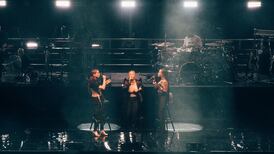ReviewedThe Land of Ousss, Koo Jeong-a, Douglas HydeGallery until June 1st (01-6081116) Constructed forLeisure, Darren Murray, Kevin Kavanagh Gallery until June 1st(01-8740064)
In Koo Jeong-a's Douglas Hyde installation The Land of Ousss, there is a sense of the artist's tentative, hesitant occupancy of the gallery. There is nothing tentative, you might say, about filling one huge wall with a grid of photographic images, as she has done. Yet even in this assertive gesture, signs of doubt and hesitation are evident.
The orderly deployment of images trails off uncertainly at the perimeters, and the images themselves are resolutely understated and oblique, physically delicate and casually presented.
Typically, they depict nondescript urban fragments, obscure little details, or the corridors and corners of sparsely furnished interiors or, on the outside, the impassive facades of city blocks.
All fairly anonymous, although there is a Parisian flavour to much of the architectural ambience, which is hardly surprising given that Koo Jeong-La lives in Paris. Cumulatively, there is a subdued, self-effacing quality to the imagery, as though the artist is ambivalent about the assertion of presence that she is making, and backs away from it even in the act of doing it.
The same holds true for the other main strand of the exhibition, her workshop space with its agreeable sprawl of bits of paper, photographs, knives and glue, obscurely allusive little notes and fragments, things that might be work, or plans for work, or indeed might be something else entirely, though there is no way of figuring out what exactly that might be. No particular strategy is evident in the bits and pieces spread across and around the work table-top, apart that is from the strategy of letting bits and pieces of stuff accumulate as they will and as they do. On closer scrutiny, some of the artist's interventions appear as being distinctly odd, such as her penchant for trimming pieces of paper in exceptionally precise though also, surely, completely arbitrary ways, and preserving every off-cut.
The sense of a work comfortably in progress, of the agreeable, gentle rhythm of a daily routine between the inconclusive wall of images on one side of the gallery and the untidy work-space on the other, is so persuasive that you expect to see the artist arrive at any moment to continue with her labour. In the normal course of events that labour would probably entail guiding her installation towards coherence.
But that does not seem to be the point here at all. Things are as we see them. The artist is elsewhere and we are left to contemplate the scattered evidence of her presence.
That she has been here, and intervened here, is clear, as is the inconclusiveness of her intervention. In all of this she has, perhaps, invited us to direct our attention towards the minutiae of daily life, its invisible contexts, the things we pass by, the unremarked emptinesses that make up the eventual something of our lives. Initially, this might seem remote from the facts of the world beyond the hushed confines of the gallery. In the midst of busy lives, filled with the routine demands of, and desire for, people, things, ideals, we may resist being steered towards these dangerous rocks of nothingness.
In this context, Koo Jeong-a doesn't offer us much, you could say, apart from a distraction from the business of living. Yet there is a sense in which her idiosyncratic interventions are exemplary, that the space has been instructively redefined by her being there. That the very idiosyncrasy of her interventions make this point. Why should that count in the end?
Perhaps, for you, it won't. In a way it is an easy exhibition not to get involved in, to dismiss. Yet if you are inclined to wonder what it is you go to an art gallery for, rather than just go to an art gallery for more of the same, it is likely that her show will engage you.
The fact and idea of space runs through her work, from depicted spaces, big and small, internal and external, to the actual space of the gallery, all inscribed with traces of an ephemeral but curiously stubborn, incalculable presence. If this presence is, ultimately, opaque to us, we might still see the conditions of our own selves reflected in it.
Darren Murray's boldly coloured paintings in Constructed for Leisure at the Kevin Kavanagh Gallery offer a wry synthesis of disparate visual idioms. They are, in no particular order, the chromatic expanses of colour field painting, aspects of the stylised representational method of Oriental art, and ornithological illustration. In drawing on these various visual conventions Murray also evokes the ways of seeing that they entail.
That is, the abstract formalism of colour field painting, our view of Oriental painting as exotic in its otherness, and the dispassionate objectivity of scientific illustration. He doesn't actually just pop these ingredients in the postmodernist blender and hit the switch labelled irony. In his impeccably made paintings each distinctive element remains carefully unintegrated, but also achieves a state of harmonious pictorial coexistence.
While his work certainly has a knowing, detached quality about it he doesn't disparage or patronise his sources. The eclecticism of the results doesn't diminish the material but allows the various relevant ideas, such as the visual and conceptual priorities of each line of approach, to float into our consciousness.
Each way of seeing also infiltrates the others as, for example, the way the ordinary, in the form of common garden birds, can be exoticised. It is a strong exhibition and one that holds out promising lines of future development.










